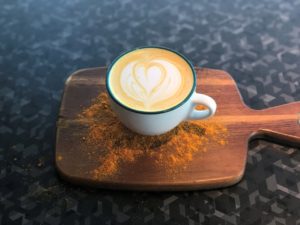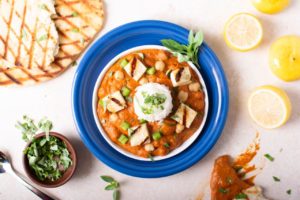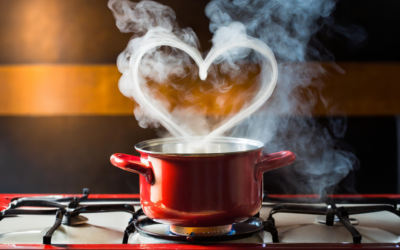You’ve probably seen turmeric in the grocery produce section, but unless you’re into cooking, you might have been put off by the spice’s dried knobby orange roots. But once the skin is peeled off those roots, there is a wealth of uses for this ancient spice.
Cultivated for nearly 4,500 years in India and Southeast Asia, where this cousin of ginger grows naturally, the roots are a culinary staple in India, Thailand and other Asian countries. In that, you might say turmeric has staying power. But now the golden spice, as it’s called, keeps popping up on food trend lists for its cooking versatility and healing properties.

Golden Latte from the Butterfly Cafe. Photo by Emmy Reinke.
Adding appealing color and flavor
Miranda Barnett, test kitchen assistant at Savory Spice, says turmeric’s popularity in culinary use comes less from its taste—Barnett describes it as bitter and pungent—and more for its earthy notes that create what cooks call a “flavor base.”
That’s because turmeric coaxes flavor from other spices: pair it with cumin and you’ll get a warm, comforting aroma; partner with paprika and you’ll notice smokiness. When combined with nutmeg or star anise, turmeric lends a musky flavor profile.
For that reason, you’ll find it in a lot of spice blends, Barnett says, particularly ones with a yellow or orange color. Curcumin, one of the many active compounds in turmeric, is prized for the yellow coloring it adds to dishes and clothing dyes.
Turmeric turns curry and dishes like tikka masala or lattes into gold. On a less esoteric note, along with mustard seeds, turmeric is what turns French’s Classic Yellow Mustard bright crayon yellow.
“Just a pinch of turmeric will turn your rice or vanilla cupcake yellow,” Barnett says. “The color is appealing. We eat with our eyes.”
Fort Collins’ tiny Butterfly Cafe serves a popular Golden Milk smoothie that starts with pineapple and house-made almond milk. Turmeric turns the drink a nice yellow color, the cafe’s general manager, Emmy Reinke, says.
There’s also a Golden Latte made with almond milk, honey, cayenne, ginger and turmeric. A bit of black pepper is added to both drinks; the compound piperine in pepper helps the body absorb turmeric.
If you’ve never tasted one, drinking a golden latte is like sipping sunshine. The spices ground the drink in earthiness, with the warm, golden fluid sweetened and thickened by honey.
As a coloring agent, turmeric often stands in for saffron, which is a more expensive spice—it’s harder to source than turmeric’s prolific roots.
The color yellow is significant in Southeast Asian cultures. Considered sacred in Hinduism and Buddhism, monks and priests of those religions wear yellow robes, and young women wear yellow clothing in springtime. A cord dyed gold with turmeric paste, called a mangala sutra, is a traditional element of Hindu marriages.
A medical spotlight on turmeric
Dr. Amy Pelloquin, a physician with UCHealth, is board certified in internal medicine and integrative medicine. Her practice combines traditional and non-traditional treatments such as those used in the ancient system of Ayurvedic medicine, which incorporates healthy lifestyle practices and herbal remedies to address health and disease. She recommends turmeric often.
She values turmeric for regulating inflammatory diseases, and it’s also a good antioxidant. She even believes its antimicrobial effects could address bacterial and viral infections. Pelloquin says data indicates curcumin helps arthritis, inflammatory bowel disease, diabetes, cholesterol control and fatty liver disease.
“Any system that’s inflamed isn’t going to work efficiently, and over time it will take a toll on the system and potentially malfunction. Based on in vitro studies conducted in laboratory settings, curcumin works on one of the major switches that triggers inflammation in the body,” she says. “It can help turn off that switch that can lead to the inflammatory response.”
She believes turmeric can be part of a healthy diet, but there aren’t studies to validate it. And you can’t just drink golden lattes to achieve good health. Eating it may not be a therapeutic, standardized dose, Pelloquin says.
To harness curcumin’s potent antioxidant and anti-inflammatory benefits, it’s best to consume it in capsules that increase absorption into the body. Since curcumin alone is hard to absorb, pairing it with a proportionate level of piperine and wrapping the compound in either phospholipids or oils increases ab-sorption. Pelloquin recommends the brands Meriva, Curcumin BCM-95, and Theracumin because the capsules’ active ingredients have 95 percent curcuminoids combined with piperine.
It also depends on your goal: impacting arthritis may require a lower dose than what’s needed for potentially modifying cancer, for example. Dosage can range from 300 milligrams to as much as 8 grams daily, depending on what you’re trying to treat or impact, Pelloquin says.
Have a conversation with your healthcare providers to determine if turmeric can help and what dose they recommend.

Want to add turmeric to your diet?
Cook this Halloumi Tikka Masala, a vegetarian curry with rich layers of flavor.
Recipe by Michael Kimball, Savory Spice Test Kitchen
Halloumi Tikka Masala Recipe
Ingredients
4 Tbsp. ghee or unsalted butter, divided
1 yellow onion, sliced thin
4 cloves garlic, minced
1 (2-inch) knob ginger, peeled and minced
1 tsp. coriander seeds
1 tsp. cumin seeds
1/4 tsp. inner cardamom seeds
2 Tbsp. garam masala, divided
1 tsp. guajillo chile powder
1 tsp. ground turmeric
2 (14.5 oz.) cans diced tomatoes
1/4 cup honey
1/4 lemon juice
4 tsp. Mayan sea salt, plus more to taste
1 (12 oz.) can tomato paste
1 (15 oz.) can chickpeas
1 green bell pepper, diced
1 lb. halloumi cheese, sliced into thin planks
1 cup heavy cream
Fresh basil, to garnish
Step 1: Toast
In a large Dutch oven, heat 2 Tbsp. ghee over medium heat. Add onion and stir frequently for 7 to 9 min. until soft and lightly caramelized. Add garlic, ginger, coriander seeds, cumin seeds and inner cardamom seeds. Sauté until toasted and fragrant, about 2 to 3 min. Remove from heat and add 1 Tbsp. garam masala, guajillo chile powder and ground turmeric. Stir for 20 to 30 seconds and transfer mixture to a blender.
Step 2: Blend
To the blender, also add 1 can tomatoes, honey, lemon juice and Mayan sea salt. Blend for 60 seconds until smooth.
Step 3: Simmer
Return Dutch oven to medium-high heat with remaining 2 Tbsp. ghee. Add tomato paste and remaining 1 can tomatoes. Cook, stirring often, for 2 to 3 min. Add chickpeas, bell pepper and onion mixture from blender and stir until combined. Bring to a boil then reduce heat to a simmer. Simmer for 30 min. to allow flavors to meld.
Step 4: Grill
Preheat grill pan over high heat. Pat halloumi dry with a paper towel. Grill halloumi planks for 1 to 2 min. per side until they are slightly melty with defined grill marks. Transfer to a cutting board and cut into squares.
Step 5: Finish
Add heavy cream, remaining 1 Tbsp. garam masala and grilled halloumi to Dutch oven. Stir until combined. Add additional Mayan sea salt to taste. If needed, add water, 1/4 cup at a time, to reach a flowing consistency. Garnish with fresh basil.







